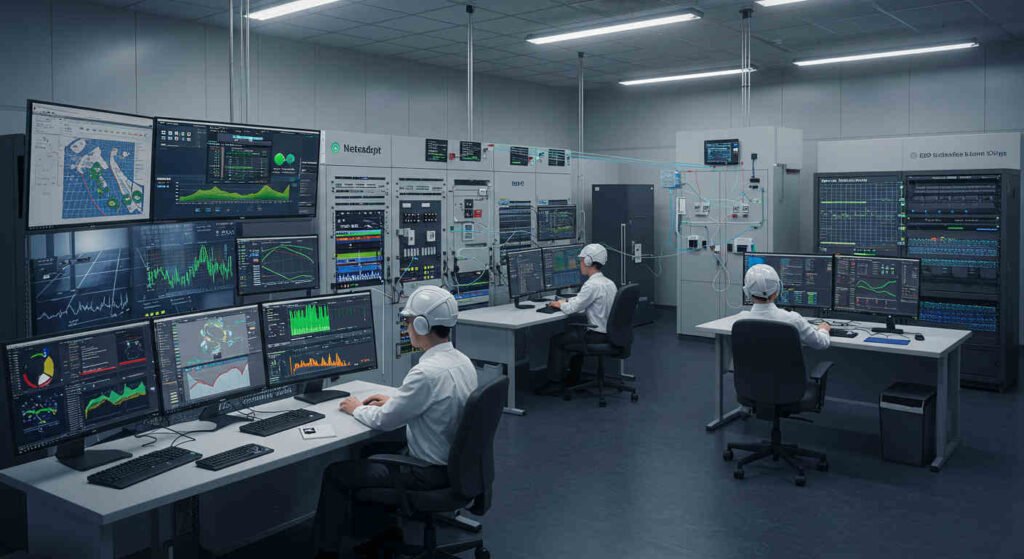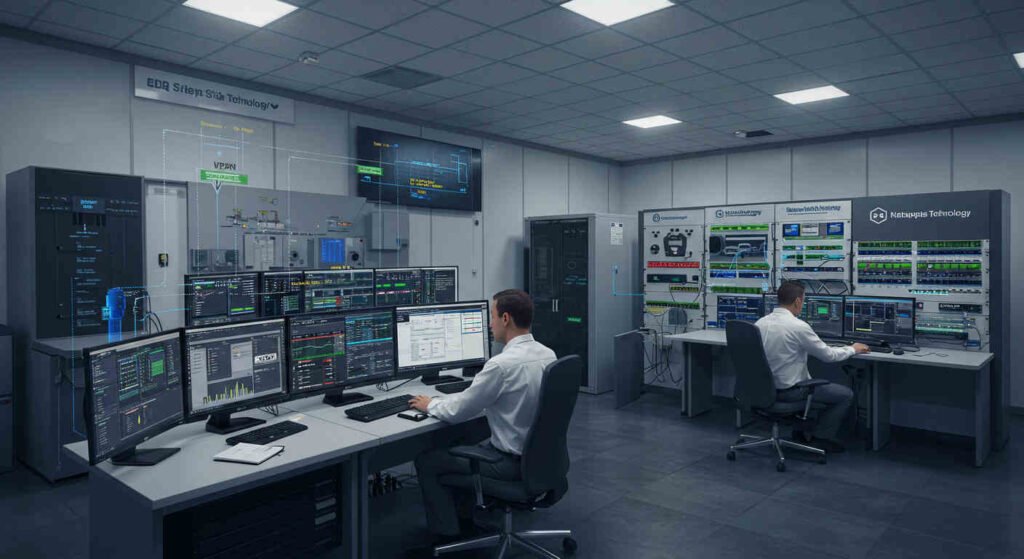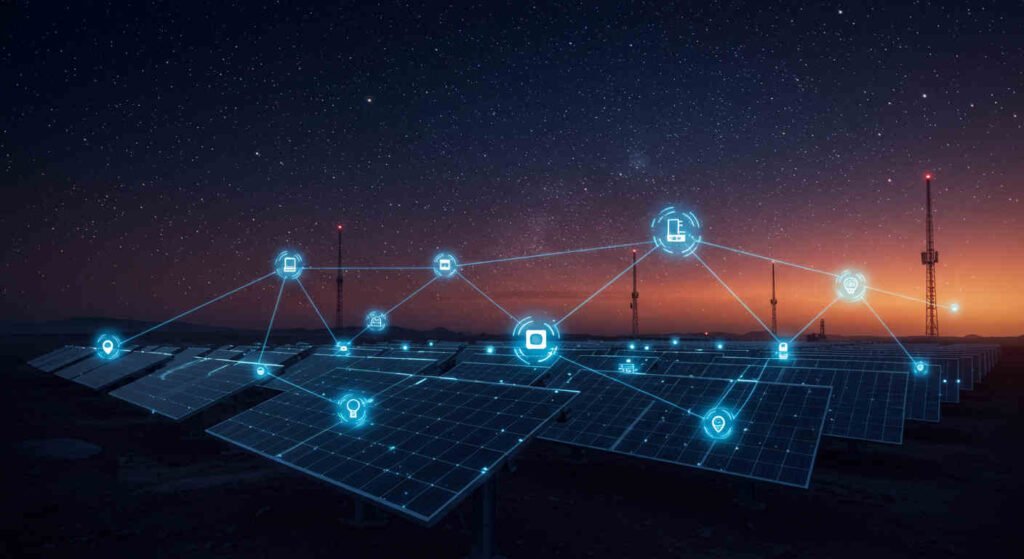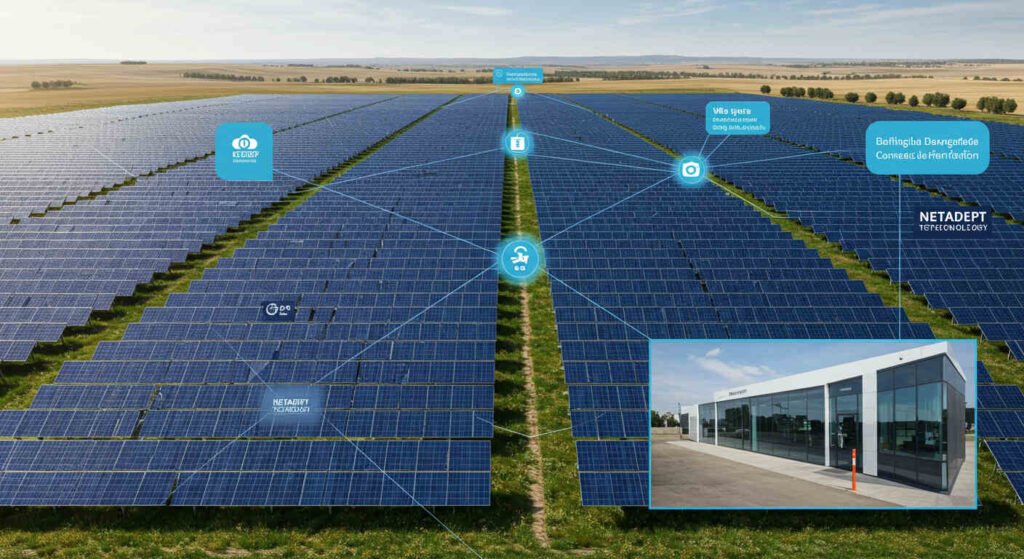Netadept Technology: Hooking Up EDP’s Solar Empire with a Slick VPN Solution
Table of Contents
Picture a sun-soaked world where clean energy hums along like a trusty old pickup truck, zipping data from far-off solar farms to a buzzing control hub, all locked down tighter than a bank vault.
That’s the masterpiece Netadept Technology painted for EDP, a big shot in the energy game, by rolling out a killer Site-to-Site VPN to tie eight photovoltaic plants to their Porto Alegre headquarters in Rio Grande do Sul. Finished in 2025, this project’s the kinda thing that makes you go, “Whoa, tech can make crazy stuff feel like a breeze!” So, buckle up, and let’s cruise through this story, packed with all the nitty-gritty details, to see how Netadept pulled off a tech triumph with swagger, smarts, and a whole lotta heart.
The Big Challenge: Roping in the Green Beast

EDP’s all about green vibes, cranking out renewable energy with solar farms that sparkle under Brazil’s blazing sun. With eight plants scattered across Minas Gerais, São Paulo, and Rio Grande do Sul, the mission was clear as day: link ‘em all to the Porto Alegre HQ with a slick solution for hooking up EDP in a way that’s safe, smooth, and tough as nails. Each plant was like a quirky cousin—different setups, gear, and remote spots—and Netadept had to weave ‘em together like a pro DJ mixing tracks, every beat in sync.
The goal? Keep critical stuff, like real-time monitoring and automation data, flowing like a river between the plants and HQ, while letting EDP’s crew tap into the network from anywhere, locked down tight. Oh, and get this: some plants, like the Granadinas ones, were built from scratch, so Netadept had to plan every detail like architects sketching a brand-new city. It was like tackling a jigsaw puzzle the size of Texas, with pieces flung across three states and a clock ticking, “Move it, the sun’s not waiting!”
The Game Plan: A Beast of a Hub in Porto Alegre

Right at the core of this project, in EDP’s Porto Alegre HQ, Netadept dropped a tech monster—an appliance with 4 CPUs, 8 GB of RAM, and a 64 GB SSD, running pfSense like a champ. This bad boy became the nerve center for the Site-to-Site VPN, like a traffic cop directing data from all eight plants with razor-sharp precision. But wait, it gets cooler: they also set up a Client-to-Site VPN with OpenVPN, using passwords and digital certificates, so EDP’s team could log in remotely with security tighter than a drum. It’s like giving only the VIPs a key to a secret clubhouse.
Now, pfSense? It’s like the ultimate toolbox—open-source, tough as heck, and ready for anything. It was the perfect pick for handling the heavy data load from solar plants. Setting it up ain’t no walk in the park; it takes serious networking chops and a sprinkle of patience. But Netadept’s crew, a bunch of tech rockstars, made it look like they were just tying their shoes.
The Plants: Each One’s Got Its Own Groove

Every solar plant had its own personality, like a family reunion where everyone’s got their own quirks. Let’s roll through how Netadept hooked each one up to the Porto Alegre HQ, nailing it every step of the way.
Rio Paranaíba Plant (Minas Gerais)
Out in Rio Paranaíba, this plant was already rocking eight internal networks. Netadept threw in a Cisco ASA-5520 firewall to set up the Site-to-Site VPN with the HQ. The trick? They used NATs (Network Address Translations) to roll out the red carpet for those networks, like saying, “Yo, Porto Alegre, check out my crew, ready to roll!” The Cisco ASA-5520, built like a tank, kept data zooming back and forth, safe and steady, no matter the miles between Minas Gerais and Rio Grande do Sul.
Cotia Plant (São Paulo)
Over in Cotia, things were simpler—just one network, but it still had to join the party. Netadept went with the same trusty appliance—4 CPUs, 8 GB of RAM, 64 GB SSD, running pfSense. They set up a single NAT to share that network with the HQ. Clean and classy, like a perfectly tailored suit. The pfSense kept Cotia locked in step with Porto Alegre, no fuss, no muss.
Janaúba Plant (Minas Gerais)

Janaúba brought a bit more heat with its five internal networks. Netadept picked a Cisco ISR4331 router to handle the Site-to-Site VPN. This thing’s like a racecar: fast, reliable, and ready to juggle multiple networks. They dialed in the NATs with pinpoint accuracy, letting Janaúba’s networks chat with Porto Alegre without any drama. It was like hosting a barbecue with five different friend groups, but everyone’s vibing perfectly.
São Gabriel Plant (Rio Grande do Sul)
Closer to home in São Gabriel, this plant had six networks and a Cisco ASA-5520 firewall. Being near Porto Alegre didn’t make it a cakewalk—each network needed to sync up just right with the hub. Netadept nailed the NATs and VPN setup, making São Gabriel feel like the neighbor who pops by the HQ anytime, always welcome and with everything squared away.
Granadinas I, II, III, and IV Plants (Rio Paranaíba, Minas Gerais)
The Granadinas plants? Man, they were the stars of the show, ‘cause Netadept built ‘em from the ground up. These four sisters in Rio Paranaíba were like blank slates, ready for a tech masterpiece. Each got the same beefy appliance as the HQ—4 CPUs, 8 GB of RAM, 64 GB SSD, running pfSense—and a VLAN setup that’s straight-up genius. Here’s the rundown on those VLANs:
- TI Transit VLAN: This was the highway connecting the plants to EDP’s corporate system, letting admin data cruise through without tripping up operations. Think of it as a fast lane for paperwork.
- UI VLAN: Built just for the Jump Server, this VLAN was like a locked safe, only letting in authorized folks for remote access. Security’s the name of the game!
- Automation VLAN: This is where the Elipse E3 servers lived, keeping an eagle eye on CLPs, HIMs, switches, firewalls, and more, all in real time, like a hawk watching its prey.
- Antivirus VLAN: Locked down like a secret bunker, this VLAN kept the McAfee server safe for updates, shielding the rest of the network.
- Management VLAN: The control room for all the gear, where Netadept could tweak things with the finesse of a master chef.
- STI VLAN: Made for talking to the trackers (those sun-chasing solar panels), this VLAN also let the tracker company access things remotely via Client-to-Site VPN from Porto Alegre.
- Guest Internet VLAN: Here’s where the heart shines! These plants are in the middle of nowhere, with no cell signal, so Netadept opened ports 80 and 443 for web browsing and WhatsApp, letting service workers stay connected. It’s like tossing ‘em a lifeline in the boondocks.
Each Granadinas plant got this same setup, like twins with their own spark. The pfSense was the beating heart, keeping everything humming like a finely tuned engine.
The Secret Sauce: That Site-to-Site VPN Magic

Let’s get to the good stuff: the Site-to-Site VPN. Think of it as a super-secure, lightning-fast pipeline linking each plant to Porto Alegre. These encrypted tunnels make sure data zips around without any sneaky eavesdroppers. It’s like mailing a letter in a locked box, only it’s flying through the internet faster than you can say “zoom.”
At the HQ, the pfSense hub runs the show like a chess master, managing those tunnels with zero slip-ups. Each plant, with its Cisco ASA-5520, Cisco ISR4331, or pfSense gear, sets up its own tunnel to the hub, letting all their networks join the big dance. The NATs were the icing on the cake, sorting out addresses so the HQ could keep track of who’s who in the data party.
The Client-to-Site VPN? Pure brilliance. With passwords and digital certificates, it’s like a double-locked door—only the right EDP folks get in. This let Sistine-Chapel-level security let engineers and techs monitor the plants from anywhere, worry-free.
The Bumps in the Road: It Wasn’t All Smooth Sailing

Now, don’t get me wrong—this project wasn’t all sunshine and rainbows. Setting up networks in remote plants, some in spots where the internet’s spottier than a dalmatian, was no joke. The Granadinas plants, built from nothing, meant planning every little thing before the solar panels even showed up. It was like building a house during a storm.
Then there was the gear—Cisco ASA-5520, Cisco ISR4331, pfSense—all with their own quirks. Getting them to play nice was like herding cats. Netadept had to be the ultimate cat wrangler, making sure every device worked together like a dream team.
And here’s another kicker: the Granadinas plants were in the sticks, with no cell signal, leaving service workers cut off from the world. The Guest VLAN with WhatsApp access was a game-changer, but it meant walking a tightrope to open just the right ports (80, 443, and WhatsApp) without letting hackers sneak in. One wrong move, and it’d be like leaving the front door wide open.
The Payoff: A System That’s Pure Gold
When it was all said and done, the result was mind-blowing. The eight plants are now like a big, happy family, with data flowing to and from Porto Alegre like a babbling brook. The Elipse E3 servers keep tabs on everything in real time, the trackers chase the sun like clockwork, and EDP’s crew can access the network from anywhere, safe as houses. Netadept didn’t just hit the mark—they blew it out of the water, building a network that’s like the backbone of a giant.
The stats don’t lie: eight plants, 29 internal networks (VLANs and all), VPN tunnels running like a dream, and not a single security hiccup since day one. EDP’s got a network that’s tough yet flexible, ready to grow as the company pushes for more renewable energy through 2026, according to the latest buzz.
Why It’s a Big Deal

This ain’t just a tech win—it’s a leap toward a greener Brazil. EDP’s got its sights set on going 100% green by 2030, and networks like this are the engine making it happen. Netadept’s VPN solution connects the sun’s raw power to the folks running the show, no matter where they are.
There’s something kinda magical about it, right? The sun’s up there, fueling the plants, while tech down here ties it all together in a digital hug. Netadept didn’t just fix a problem—they’re helping make clean energy a living, breathing reality.
What’s Next: More Sun, More Connections

Looking down the road, Netadept’s already gearing up for the future. EDP’s aiming for 500 MWp of solar power by 2026, and this VPN setup could be the foundation for that growth. Who knows how many more plants will join this data rodeo? With Netadept in the saddle, every new solar panel’s gonna find a network ready to roll out the welcome mat.
And, just between us, this is only the start. In a country where solar power’s popping up faster than dandelions, projects like this are gonna put Brazil on the map as a green energy superstar. Netadept Technology, with its chill vibe and top-notch skills, is proving you can be a big player and still keep it real.
So, how ‘bout we toast to this victory? ‘Cause connecting solar plants is like linking today to tomorrow—and Netadept did it with serious style.
If you need support with your technology solution, contact Netadept Technology!
See this another good article in our WebSite: https://techforgewave.com/upgrading-to-a-ddr5-ram-kit-save-your-money/










